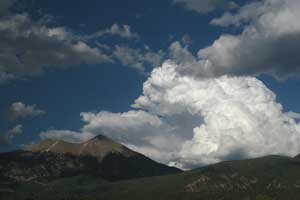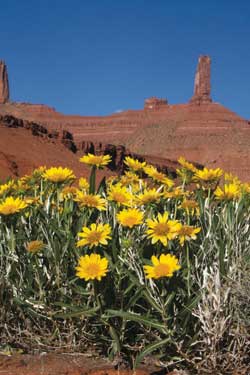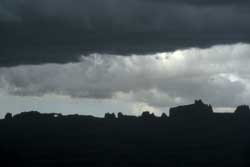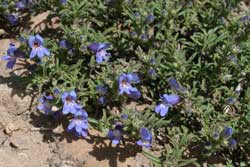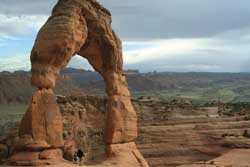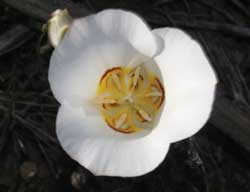Geology. Biota. Climate. Three big factors that shape, inhabit and define the Canyonlands landscape. This year the colorful geologic formations created a backdrop for the spectacular wildflower display created by a wetter-than-normal winter and spring weather pattern. Explosions of wildflowers rocked the landscape, testimony to the wet weather awakening the seeds out of dormancy. Spectacular, incredible, awesome – three words that barely described the extent of this season’s wildflower display.
And as June rolls into July, the show just keeps on going…except for moving upwards into higher elevations as summer brings the heat.
The Rocks Themselves
Mostly sedimentary formations write the geologic story of this area. Thousands of feet of sands, silts, and clays are pockmarked with the fossilized remains of ancient trees, dinosaur bones and, most unlikely of all, sea creatures such as corals, crinoids and shellfish. Each layer represents a stretch of time dominated by different climates that gave rise to unique assemblages of plants and animals.
Spectacular in their own right, these various layers of sediments were compressed into rocks, and then altered by the forces of uplift, erosion and weathering into the features we see today. Not to take anything away from the classic features of arches, bridges and canyons that resulted from these erosive actions, but this year’s wildflower display and wild weather activity took center stage over the rocks in daily conversations.
Flora and Fauna
Today a diverse assemblage of plants and animals from sand verbena to sagebrush, ravens to red-breasted nuthatches, and bull snakes to badgers now call this place home. After a long winter of rain, snow and cold temperatures, followed by a greater-than-normal wet spring, the desert erupted with wildflower displays unseen for many a year. Fields of sego lilies, yellow bee plant, globemallow and other plants rose like proverbial Phoenixes from the ashes of soil. Seeds long dormant awoke, and a mosaic of color carpeted the red rock desert.
Perhaps the abundance of seeds produced from all those blooms and the wealth of vegetation produced will enhance the survival rate of the first tier of consumers associated with this environment. Their fecundity, in turn, may impact the survival rates of predators that prey upon these consumers. Cycles within cycles.
An El Niño Year
Changes in Pacific Ocean currents this winter created a shift in the Jet Stream which looped from the Pacific Northwest up into Canada then dropped down to the Southwest. Bringing moisture and cold temperatures with it, the snow and ice stayed well into spring. Moabites surfed the Internet for warm weather escapes or strapped on skates and cruised the ice. Many swore they would never complain about the heat no matter how hot it gets this summer as long as winter disappeared like a bad dream. Pledges and promises made under the duress and stress of winter melt under the summer sun. Here’s to the heat of summer which defines this landscape as much as the rocks and plants and wildlife do.
As politics and the weather dominate most Canyon Country conversations, at least there is a bright spot to the climatic side of these talks. And that is the blooms of paintbrush and penstemon, lupine and lily, cliffrose and cacti that continue to bathe this incredible landscape with a patchwork of summer colors. Dramatic and dynamic, the Big Three continue to shape and define this land of rock and sand.
